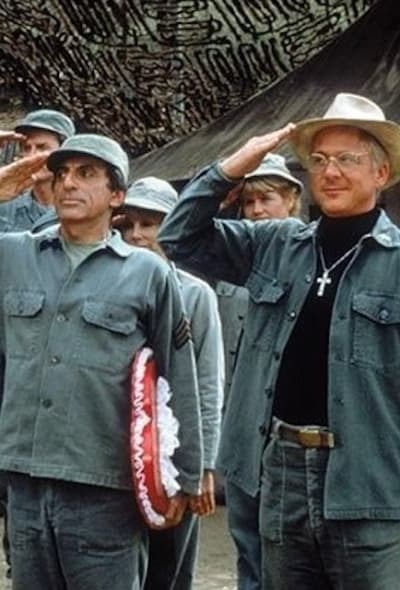On February 28, 1983, CBS aired “Goodbye, Farewell and Amen,” the two-and-a-half hour series finale of the beloved Korean War drama M*A*S*H.
With its 11-season run, M*A*S*H lasted nearly four times as long as the military conflict it depicted, but the show never experienced the viewership erosion so common to aging series these days.
Far from it, in fact.
In an astonishing feat that’s still a source of awe nearly 41 years later, the M*A*S*H finale pulled in a whopping 106 million viewers.
To put that in perspective, only about 99 million Americans tuned in to watch Super Bowl LVI on NBC in 2022.
And that was up from the previous year when a paltry — by Super Bowl standards — 92 million viewers tuned in to watch CBS‘ live broadcast of the big game.
The big game rebounded last year, as 112 million people saw Patrick Mahomes and the Kansas City Chiefs edge out Jalen Hurts and the Philadelphia Eagles, making it the most-watched Super Bowl in history.
The NFL is likely hopeful that this year’s contest will beat those numbers as the Chiefs return to the sports world’s biggest stage, this time with Travis Kelce’s girlfriend, Taylor Swift, in tow.
But it’s a testament to how much our viewing habits have changed that it takes a combination of the biggest sporting event of the year and the most famous entertainer on the planet to deliver ratings that might hope to compete with the series finale of a network drama in the early ’80s.
Now, obviously, the M*A*S*H finale was a monumental event and not the sort of thing that happened every week, or even every year.
And viewers have far more entertainment options now than they had during the Reagan era.
But it’s also worth noting that the US population was smaller by about 100 million people back then, and yet, no scripted drama has come within shouting distance of delivering “Goodbye, Farewell and Amen” numbers in the decades since.
In recent years, the closest thing we’ve seen to that sort of event TV was Game of Thrones, which became the rare premium cable series to pull in eight-digit viewership.
The Game of Thrones series finale drew an astonishing 19.3 million viewers, a figure that HBO execs are no doubt reflecting upon with misty eyes these days.
The network’s biggest hit over the past two years was the GoT spinoff House of the Dragon, which averaged a comparatively paltry 2.7 million viewers.
The situation is only slightly better at the major networks, where CBS’ Fire Country delivered the most-watched single episode of a scripted series with an audience 12.2 million.
Meanwhile, the streaming services and basic cable channels are being kept afloat by defunct series of yesteryear (Suits, Grey’s Anatomy, Friends, The Big Bang Theory) and a dwindling pack of original shows, several of which either just came to an end or are about to.
Last year’s most-streamed show, Ted Lasso, has already wrapped up its run on AppleTV+, and basic cable’s reigning king Yellowstone is set to come to an end later this year.
Over at Netflix, execs are likely in a panic over the news that Stranger Things will be airing its final eight episodes in 2025.
No English-language show has yielded more streaming hours, and in a reversal of recent industry-wide trends, Stranger Things most recent season was its most popular.
There was a time, not all that long ago, when a person in the position of Netflix’s chief content officer Bela Bajaria might have felt confident that the next big, buzzworthy hit was right around the corner.
Shows come and go, after all, and while the occasional slump is inevitable, a platform with the development budget of Netflix is sure to hit paydirt eventually, right?
Sadly, we can’t be so sure anymore, as the current TV landscape is difficult to navigate and less likely than ever to reward risky ventures.
As audiences continue to turn away from original scripted content, it just doesn’t make sense for execs to greenlight expensive, experimental stories like the saga of a group of teens from Hawkins, Indiana.
In total, 93 of last year’s top TV broadcasts were football games.
And while it’s great that Americans can still find common ground at the 50-yard line, current viewing trends might be bad news for the future of television in particular and pop culture in general.
When football is the only thing that can deliver the same-size audience that tuned in for a midseason episode of Seinfeld circa 1996, you can be certain that network execs will remain more focused on locking down a deal with Roger Goodell than on finding the next great sitcom.
And streaming services are now jockeying for elbow room at that already-crowded table, with Amazon Prime Video and Peacock both shelling out big bucks for the exclusive rights to NFL games.
The shrinking audience for scripted fare has made Netflix and other platforms more cancel-happy and risk-averse than ever, which is why shows that might have once been given a chance to find their footing are now axed after a single season.
The situation has us pondering a future in which Americans have no shared cultural touchstones, no shows or movies that they can quote to put a smile on the face of the fellow drone in the next cubicle.
In that world, will sports and the weather be our only acceptable small-talk topics?
What do we do during those desolate months between the Super Bowl and the start of training camp?
And what about folks who aren’t football fans? Will they be forced to limit their discussions to matters meteorological?
More than any other medium, television has always had the power to unite, and scripted series are unique in their ability to make us feel as though we’re sharing an experience — participating in an ongoing conversation with folks with whom we have little else in common.
In a country that’s divided on just about every other issue, TV is one of the few things that can bridge the gap between opposite ends of the political spectrum.
Wee shudder to imagine a world where those water cooler conversations don’t run any deeper than assessments of this year’s Super Bowl commercials.
Tyler Johnson is an Associate Editor for TV Fanatic and the other Mediavine O&O sites. In his spare time, he enjoys reading, cooking, and, of course, watching TV. You can Follow him on X and email him here at TV Fanatic.
Read the original article here










